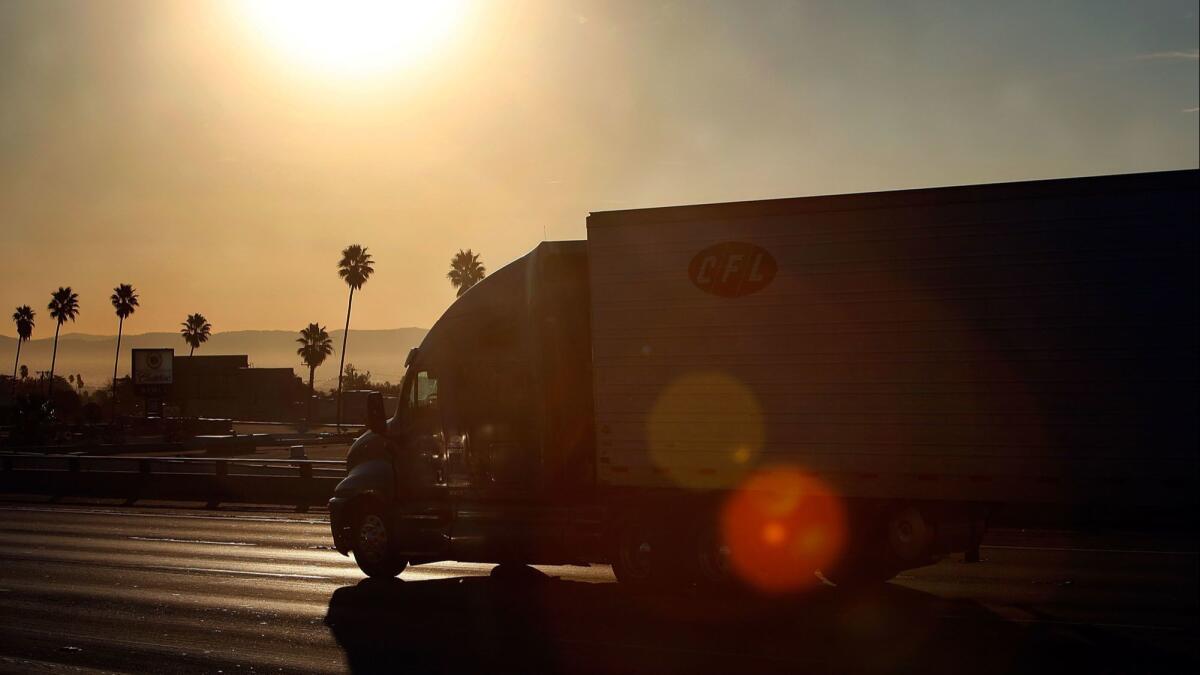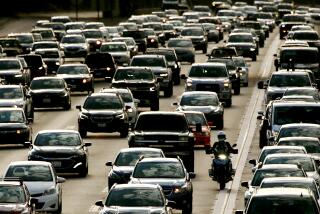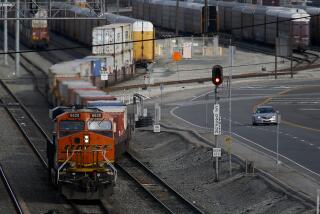Slowdown in emissions reductions could explain stalled progress on smog, study finds

After decades of improvement, reductions in smog-forming emissions have slowed dramatically, according to new nationwide study based on satellite measurements. The findings could explain why progress cleaning air pollution in California and other parts of the country is faltering at a time when official estimates show pollution should be steadily declining.
Emissions of smog-forming nitrogen oxides declined by 7% per year from 2005 to 2009, but fell by only 1.7% annually from 2011 to 2015, even increasing in some areas of the United States, according to the study in the Proceedings of the National Academy of Sciences.
The slowdown was discovered by an international team of researchers who compared official U.S. Environmental Protection Agency emissions inventories to actual measurements of pollution in the atmosphere from satellites and ground-based air monitoring stations.
âWe were surprised by the discrepancy,â said lead author Zhe Jiang, a professor at the University of Science and Technology of China.
The findings are the latest sign air quality gains are weakening following decades of progress under the Clean Air Act, and show that cleaning smog to federal health standards will be tougher than previously thought. They also suggest a shift in the types of pollution causing poor air quality.
As one explanation, researchers cited diminishing returns from cars and power plants. Regulations years ago led to air quality improvement as cars came equipped with catalytic converters and power plants switched to low-nitrogen oxide burners. That may also explain a similar slowdown researchers detected in carbon monoxide, which is emitted largely by cars.
The past success, however, has increased the relative contributions of other, less obvious pollution sources, such as industrial boilers, residential water heaters and construction equipment.
âAs you become effective at controlling emissions from cars and power plants, the other sources become more important and thereâs less information about them,â said co-author Brian McDonald, an atmospheric scientist at the University of Colorado, Boulder.
Another possible culprit cited in the study are diesel trucks, for which researchers found a slower-than-expected reduction in emissions of nitrogen oxides.
The study found that real-world emissions of nitrogen oxides from diesel trucks in the 2011 to 2015 time period decreased at about half the rate of EPA estimates.
Researchers examined data from recent studies that show diesel trucks driving in real-world conditions spew more pollution than under laboratory emissions tests and that their emissions-control systems are less effective than assumed by regulators. The pollution control technology on heavy-duty trucks is more recently mandated and less advanced than on passenger cars.
Researchers say the slowdown will make it harder for regions across the country with poor air quality to meet health-based standards for ozone, the lung-damaging gas in warm-weather smog. In 2015, the Obama administration tightened the EPAâs limit on ozone to 70 parts per billion.
Nowhere is farther from meeting that standard than Southern California, where ozone levels in inland areas spiked as high as 158 ppb last summer.
Following decades of improvement in Southern California, progress has tapered off recently in reducing ozone, which inflames the lungs and triggers asthma attacks and other health problems. The number of bad air days have gone up the last two consecutive years, with the region violating federal health standards for ozone on 145 days last year, up from 132 days in 2016 and 113 in 2015.
The South Coast Air Quality Management District blames the recent dive in air quality on hotter temperatures and more inversion layers â weather patterns that trap pollution near the ground â but officials have said they are looking into whether their estimates showing a steady decline in emissions are somehow off.
Scientists say rising temperatures from climate change will make smog tougher to control by boosting the photochemical reactions that generate ozone pollution. But they say itâs too soon to determine whether global warming is the primary driver behind the recent uptick in California.
To meet looming federal deadlines, the regionâs regulators say, Southern California must go beyond existing regulations to slash nitrogen oxide emissions an additional 45% by 2023, and another 10% by 2031.
In the study, scientists considered, but rejected, the possibility that pollution blowing over from China and other Asian countries could be playing a role.
âThe data donât support that hypothesis,â said National Center for Atmospheric Research scientist Helen Worden, a co-author of the study.
In one sign that pollution from Asia was not to blame, the slowdown in pollution reductions was more pronounced in the Eastern U.S. and less severe in the Southwest, particularly in California where there are tougher emissions rules.
Researchersâ findings contrast with another recent study that found nitrogen oxide emissions from vehicles in Europe declining more steeply than assumed in government projections.
More to Read
Sign up for Essential California
The most important California stories and recommendations in your inbox every morning.
You may occasionally receive promotional content from the Los Angeles Times.











